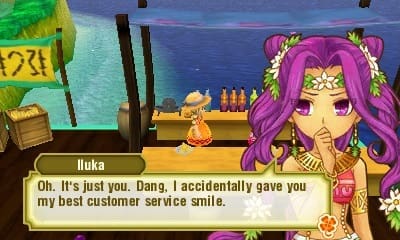
Howdy, everyone!
I’m writing from down on the (localization) farm with an update. The past two months have seen a bevy of releases, from Touhou: Scarlet Curiosity to Xanadu Next, but there hasn’t been much news on one of our biggest titles, STORY OF SEASONS: Trio of Towns, after the pre-order bonus capybara plushy announcement.

(The plushy looks kind of like this, but without the onsen towel!)
I’m one of the newest members of the XSEED team—though this is my third time working for the company (long story)—and I’ve been guiding Trio of Towns from the editing phase through QA testing. My super senpai Brittany strongly encouraged me to write a localization blog (or 10), so I thought I’d take a quick break from the text farm to give you all a brief introduction to this new, enormous entry in the series.
…And I mean enormous. This Japanese text for this game is around 2 million characters, making it easily the biggest title in the series’ 20-year history. (For comparison, the last Story of Seasons title had 1.7 million characters.)
That’s a big number, and maybe a little hard to wrap your head around. Consider these two things:
1. We expect full-time translators to complete 125,000 characters a month.
2. As with past titles, we created a spreadsheet containing all text in the game. See localization blogs about the last Story of Seasons title and Trails in the Sky Second Chapter for more on this. For the latter title, in particular, the spreadsheet was too large to use. We solved this problem for Trio of Towns by making TWO spreadsheets.
This is so much text that it sometimes feels like we’re up to our necks in dialogue, item descriptions, and festival cut scenes. Thankfully, several of us are longtime fans of the series, so we’re invested in bringing you a polished, expansive game that we hope will feel familiar at the same time.
While working on Trio of Towns, I’ve reflected on playing the Nintendo 64 version for hours and hours over 15 years ago. As some no doubt remember, back then your bag could only hold eight items and you’d have to take a sickle to one of your regenerating crops (corn, tomatoes, eggplants) in order to harvest the middle one. While the older games had a lot of charm, I’m amazed by the amount of content that’s stuffed into the newest iteration.

Even as we work on the game, we’ve been paying attention to fan reactions to information as it’s been released from Japan. One of the biggest concerns I’ve seen from fans so far is: “Will Trio of Townsforce me to choose which of the three towns to live in? (And will I have to choose an emphasis on livestock or farming?)”
At least to those two concerns, the answer is a resounding “no.” Your farm is a hub area at the bottom of the map, from which you can access the three towns. While you cannot move your farm to any of the towns, the game features an astounding number of decorations and additions to give your farm a “Western,” “Eastern,” or “Tropical” flair. You can also choose costumes, crops, and even pets that will give your farm a consistent theme, or you can mix everything together. Each town has festivals, but in most cases, you won’t be forced to choose between festivals. There are also competitions in which all three towns participate.
With that, I’d like to introduce the three towns with some comments about localizing them.
Westown
Westown is the first town you’re able to visit, and it is home to your Uncle Frank, a jolly farmer known for his tiny hat, skills with a pizza oven, and his love of explaining game mechanics.

The crops and animals on sale in Westown will be familiar to Story of Seasons players, as will the general vibe of the shops and residents. Westown’s two bachelors are Wayne, the postman, and Ford, the doctor. Wayne is the handsome-and-knows-it type. I settled on his “voice” in my head when I filled in as an assistant on the Akiba’s Beat English voice recording for a day, and actor Mick Wingert played his character (“Boss”) as a cowboy.
One thing that I know fans of this series are passionate about is accurate naming and terminology. As mentioned above, I joined Trio of Towns after all the text had been translated, but I had been playing the Japanese retail version for a few months leading up to becoming part of the team. I was surprised to learn upon starting work at XSEED that the Westown florist, one of the bachelorettes, had been translated as Carolina. This was due in part to the difficulty of rendering her Japanese name, which comes from Rescht (a variety of rose) but sounds much prettier when said in Japanese (Lishietto). “Lisette” had been discussed as an alternative back in the early stages of localization, but had been scrapped in part because it doesn’t capture the metaphorical connotations of the name.
After working on the game for about a month, I raised the possibility of changing her name to something closer to the original, and after some good discussions in our office, we decided that Carolina should become Lisette. Needless to say, the Story of Seasons fan in me was pleased with the outcome.

Lulukoko Village
With its unusual wild animals and a big ruin on the outskirts of the town, tropical Lulukoko has a mysterious vibe all its own. The mainstays of the local economy are aquaculture and fruit trees. While you can no longer go swimming and diving as in Story of Seasons, you can still catch and cultivate fish in nets on Lulukoko’s coastline.

A “quick greeting” from one of the game’s many supporting NPC villagers.
As in the Japanese version, the characters sprinkle their sentences with a language other than the game’s main language. In Japanese, it was a made-up language that added “-nga” to common words. So “arigato” (thanks) became “aringa” and “gomen” (I’m sorry) became “gominga.” Instead of messing around with creating a gibberish language in this fashion, we decided to use Hawaiian in the English version in keeping with the town’s Polynesian atmosphere. So you can expect a lot of “Alohas” and “Mahalos,” but also some other interesting phrases that were new to me. I’ve recently been playing a certain other blockbuster 3DS title set in a Hawaii-inspired land, and I’d say we probably have more Hawaiian language, but less slang like “shoots.”
Lulukoko features a seaside café run by the twins Iluka and Siluka, bachelorettes who are, naturally, polar opposites. The sassy Iluka is one of my favorite characters to read in the English version.

Iluka has no time for your freeloading.
Tsuyukusa Town
The last town you can visit in Trio of Towns is a Japanese farming village. The locals grow rice and other paddy crops, and the town features a small shrine, torii gates, and a lively teahouse.

Father-daughter team Ginjiro and Komari run Tea-ful Reunion together.
One of the things that has been challenging about localizing Tsuyukusa is capturing the “Japanese” feel of the village without throwing a bunch of Japanese words (that aren’t common knowledge) at players. References to culture and literature haven’t been excised entirely, as we think that would take away a lot of what makes Tsuyukusa exciting, but we’ve done as best we can to render these intelligible and natural in English without making things read like a lecture. Kasumi, one of the game’s bachelorettes, is a teacher with a classical education. She made this task particularly difficult at times.

As a teacher, sometimes Kasumi’s dialogue necessarily reads like a lecture…
That’s all I have for now. Working on this title has been stressful at times, but I’m so excited for fans of the series (and some newbies, hopefully) to get their hands on it. I’m looking forward to writing and reading more Trio of Towns localization blogs over the coming months. I hope you will be as well.
-John

